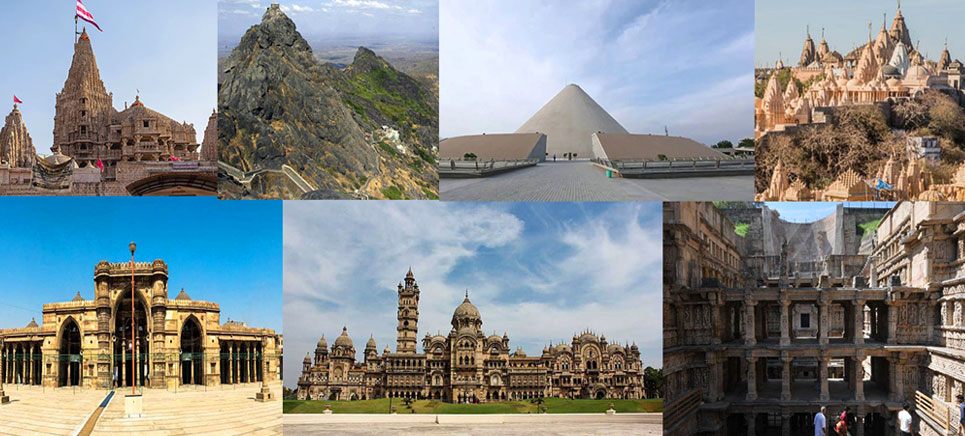Introduction
Gujarat is a colorful Indian state located on the western coast of the country and famous for its historical past, cultural heritage, and beautiful scenery. It is a region with huge potential that provides visitors with diverse sights and activities to suit any interest in travel. From the spiritual touch of global icon Mahatma Gandhi at the Gandhi Ashram to the architectural beauty of Dwarkadhish Temple or the Statues of Unity which are incredible the top ten attractions of Gujarat will enthrall you for sure. Every place reflects some aspect of Gujarat’s rich culture and the state’s progress and accordingly, Gujarat forms an ideal vacation spot for tourists. Explore this guide to get information about the popular tourist destinations in Gujarat and turn your trip into an extraordinary adventure.
Gandhi Ashram

Sabarmati or Gandhi Ashram is located in Ahmedabad, Gujarat, which is one of the most significant sites in the country. Formed in 1917 by Mahatma Gandhi, the ashram became the nerve center of the Indian freedom struggle. This was a favorite spot of Gandhi who wanted people to embrace non-violence and live an independent life as well. The ashram was the point of origin of the famous Dandi march in 1930 in the Indian freedom movement. Today, the ashram continues to be a reminder of Gandhi and his commitment to the change of society and politics. The ashram has several important buildings like the Hriday Kunj where Gandhiji lived, the Gandhi Memorial Museum, etc. The house where Gandhi and his wife Kasturba stayed, known as Hriday Kunj, has also been converted into a museum where one can learn about Gandhi’s life and ideas.
The Gandhi Memorial Museum inside the ashram encompasses many artifacts, photographs, and documents of the freedom struggle and Mahatma Gandhi. These exhibits give the visitors quite a deep insight into Gandhian philosophy and his contribution to the freedom movement of India. Here at the Gandhi Ashram, tourists can enjoy a calm and quiet environment, which is great for studying. The extensive gardens of the ashram, basic accommodations, and the serene location near the banks of the Sabarmati River help foster this sense of reflection. For both learning purposes and personal enlightenment, there are educational tours and various programs that are conducted within the ashram to avail enhanced knowledge of Gandhi’s principles and the importance of the ashram. The Gandhi Ashram is still an important place for tourists who want to learn more about India and the actions of Mahatma Gandhi.
Dwarkadhish Temple
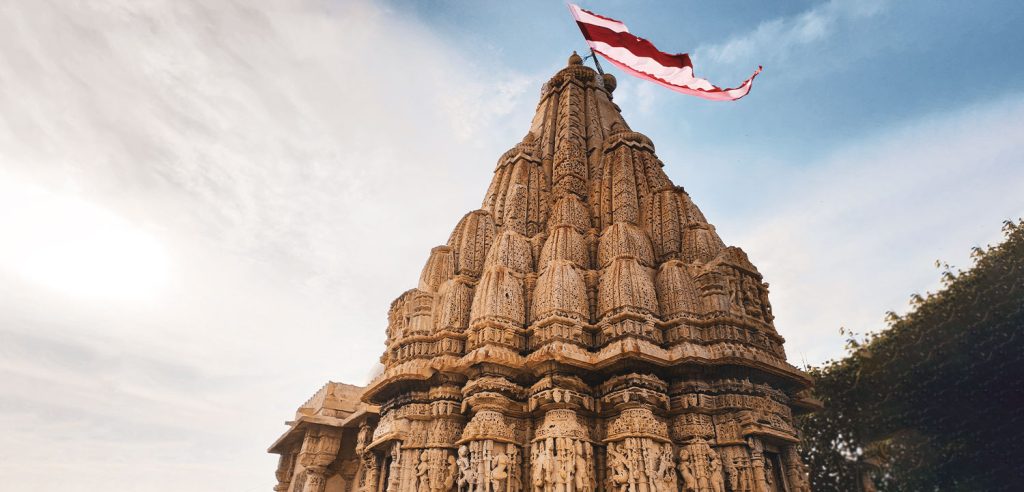
Dwarkadhish Temple is one of the Char Dham pilgrimage sites and an important temple of Lord Krishna stationed in the historical Dwarka city. It is one of the most famous sacred places and a notable example of architectural design as the temple is said to have been built by Lord Krishna. Its importance lies in the fact that after marrying Rukmani, Krishna has become the king at Dwarka hence making the temple a major shrine of religious practice. The building has elaborate designs and carvings on the roof and a towering spire, a sanctum sanctorum housing the idol of Lord Krishna with thousands of devotees visiting every year. Complex wooden carvings and sculptures found on the structure are the actual representations of the ancient Hindu architectural designs. One of the most popular sacred structures is the Dwarkadhish Temple, also known as Jagat Mandir, with the complex and intricately built main shrine.
The temple complex contains many small sub-temples serving different gods and these sub-temples are uniquely constructed and hold distinct religious value. The surrounding environment is just as interesting and filled with active bazaars and numerous other temples that add to the spiritually charged nature of the area. Visitors going to Dwarkadhish Temple have the opportunity to see the functioning of an active temple that has daily puja and Archane and rituals. Visitors, especially devotees, can indulge in prayer rituals or ceremonies like the traditional aarti, take part in religious festivities, or even acquaint themselves with the temple’s historical significance as presented in its galleries and other attractions. The town of Dwarka with its ancient history and religious atmosphere adds value to the temple visit and it becomes more of a divine tour providing spiritual satisfaction. Even today Dwarkadhish Temple is an icon of the Hindu faith and is a compulsory visit for anyone in search of divine experience.
Statue of Unity
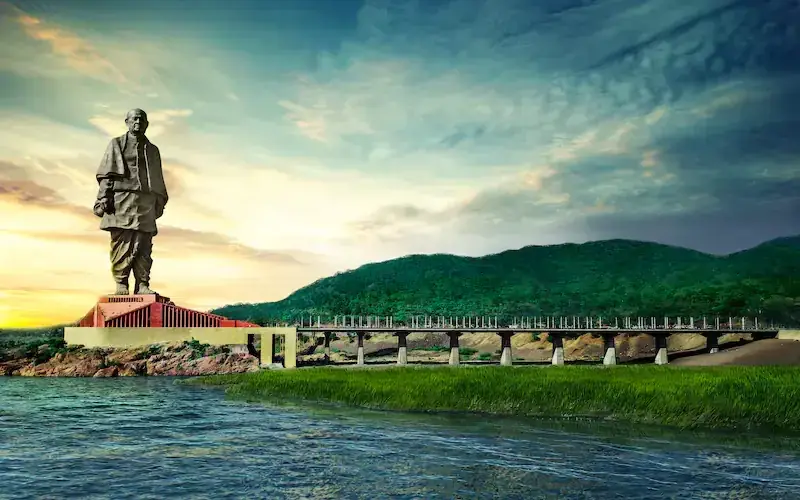
The recently inaugurated Statue of Unity in the Narmada district of Gujarat is the tallest statue globally with a height of 182 meters. This world’s tallest statue is in honor of Sardar Vallabhbhai Patel who played an instrumental role in India’s freedom movement and integrated India. The giant statue revealed in 2018 is not only a civil, structural, and architectural engineering marvel but also symbolizes Patel’s dream of a united India. The location of the statue in Sadhu Bet Island and other structural developments draw attention to its importance and magnanimity. Surrounding the Statue of Unity are other structures such as an exhibition hall, a museum, and a viewing gallery. Various aspects of Patel’s life, his achievements, and the roles he played in India’s independence are described in the exhibition hall.
The attractions include photographs, documents, and other items that tell Patel’s story and his contribution to modern India. The higher level of the viewing gallery of 153 meters gives a spectacular view of the Sardar Patel Samadhi and the river Narmada making this memorial immense. The massive and highly artistic concept in its construction alone makes this statue outstanding. Created by Indian sculptor Ram V. Sutar, the statue is detailed and stands on a structure of steel beams. The area surrounding the castle has been turned into a tourist attraction site that has features such as gardens, an adventure park, and a research station. Currently, the Statue of Unity has become one of the major attractions for tourists both within the country and from other parts of the world to pale a tribute to one of the most respected leaders of the country.
Sabarmati Riverfront
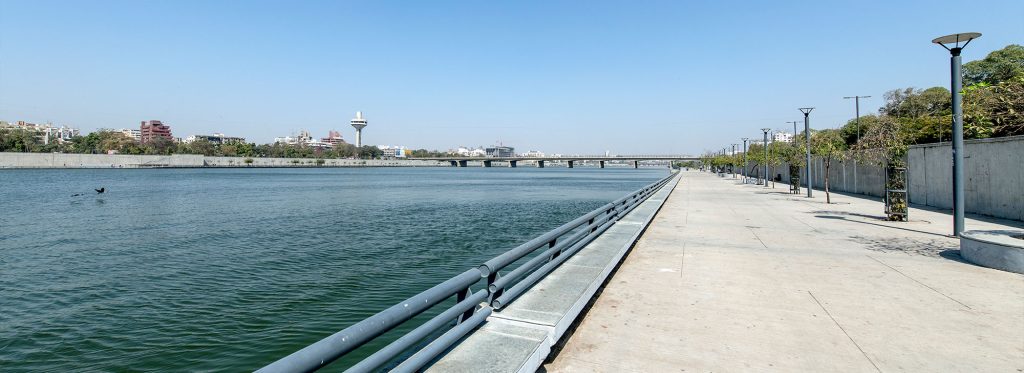
Sabarmati Riverfront in Ahmedabad is a new-age urban infrastructure development that changes the dynamics of the Sabarmati River. This large-scale project is designed to restore the river bank and develop an active recreation area for citizens and visitors. The river channel has other facilities including walkways, a green belt, and recreation grounds for people to enjoy natural beauty after being surrounded by concrete jungles. It has been useful in the development of urbanization, giving the city an aesthetic backdrop to many activities and shows. The Sabarmati Riverfront is developed for various purposes such as recreational and cultural activities. The riverfront features paved pedestrian and cycling trails, water-based activities, and areas for recreation and group functions. It is used for hosting fairs, carnivals, shows, and other cultural events and programs due it its lively cultural lifestyle of Ahmedabad.
The development of the riverfront has also benefited the city in terms of the sustainable use of water as well as the overall health of the river. Tourist attractions in Sabarmati Riverfront include walking and boating by the river, parks, and gardens in the vicinity. As for its design, like many other modern parks and public spaces, the riverfront features appropriate structures and ornaments. The project of the Sabarmati Riverfront can be considered a successful example of an urban renewal project that integrates nature and architecture. It brings the possibility to see the most modern part of Ahmedabad and have a beautiful view of the Sabarmati River at the same time.
Somnath Mahadev Mandir
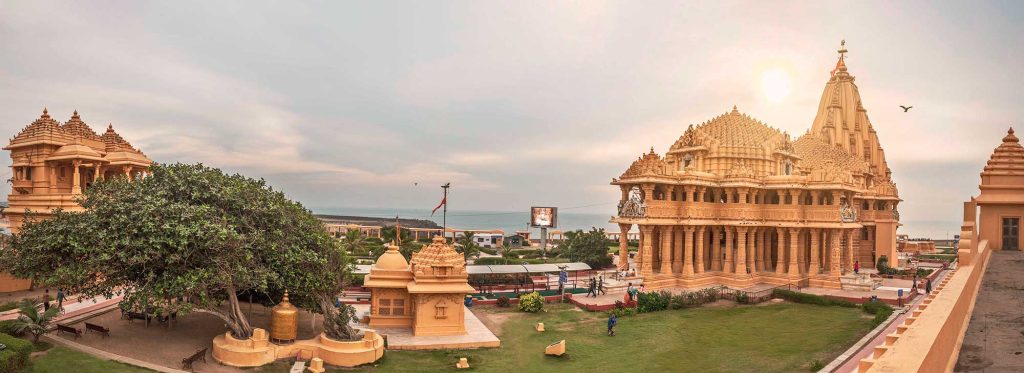
Somnath Mahadev Mandir in Prabhas Patan near Veraval is one of the twelve Jyotirlingas, therefore, it is an important center of pilgrimage for Lord Shiva devotees. It has been established that this building was a temple and has several religious and cultural importance. According to history, the temple was built by the Moon God Chandra and holds an auspicious position in the Hindu religion. Due to its history and the cultural value of its architecture, many people visit it as pilgrims and tourists. The temple design is beautiful with the incorporation of both traditional and modern designs and has a magnificent look due to its historical context.
The construction of the Somnath Temple has been accomplished multiple times because of the several invasions that have taken place, which represents the tradition’s continuation despite the invasions. The sanctum sanctorum is a lingam of Shiva; the temple has a few more shrines which are comparatively smaller than the main temple and some monuments which give a pious look to the temple. The devotees and tourists who visit Somnath Mahadev Mandir can witness puja and many other rituals like Aarti and Abhishekam etc. The height of the temple is a bonus for its appearance; it is built close to the Arabian Sea, which helps to create a tranquil environment for the devotees. Somnath Mahadev Mandir continues to be one of the most significant pilgrimage sites for the devout and those interested in exploring India’s historical and cultural spiritualism.
Lakshmi Vilas Palace

Currently situated in Vadodara, the Lakshmi Vilas Palace is a fine specimen of Indo-Saracenic architecture and a true reflection of the Maratha kings’ luxurious lifestyle. The palace is also one of the finest examples of Indo-Saracenic architecture, was built in 1890 by Maharaja Sayajirao Gaekwad III with splendid Baroque, features wide courtyards, over 600 rooms, and lavish furnishing and decoration. The building was constructed by the British architect Charles Mant, and it features a blend of Indian, Persian, as well as European architecture. The grandeur comes out clearly through the tall ceiling, plaster work, carving, and wide corridors of the building. Some of the magnificent amenities in the palace complex comprise the Durbar Hall which has been designed with Venetian chandeliers and has fine artworks among others.
The interior of the palace is marvelously decorated with marble floors, carved ceilings, and both European and Indian furniture. Lakshmi Vilas Palace also has a museum that contains information on the royal family and their possessions such as clothes, documents, and automobiles which were once owned by the royal family of the Gaekwad dynasty and gives a clear view of the luxurious lives of the royal family. After getting to know the general information about the Lakshmi Vilas Palace, visitors can take a guided tour to see the rooms and galleries of the palace. There are beautifully landscaped gardens and courtyards around the palace which made the area ideal for strolling. It also serves to accommodate cultural events and exhibitions therefore making the place more enjoyable for one to visit. Lakshmi Vilas Palace remains an important monument in Gujarat representing its royal past and is a place worth visiting for its architectural marvel.
Adalaj Step-well
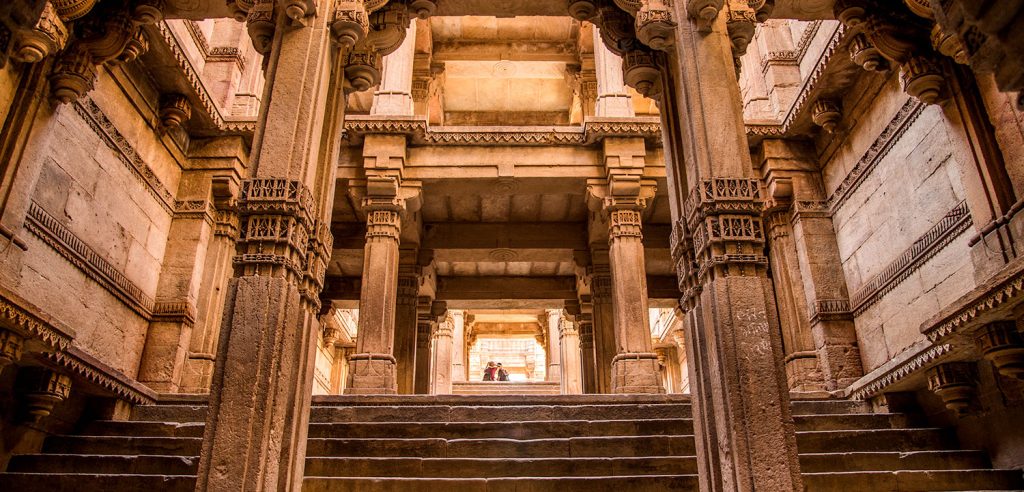
The Adalaj Step-well which is situated near Gandhinagar is a wonderful piece of the engineering marvel of ancient India. Originally constructed in 1499 by Queen Rudabai, the step well was indeed functioning as a means of water supply and as a locality social center. The step-well is famous for its carving, and architecture and is elongated with three tiers of steps leading down to the water. It has elaborate carvings and reliefs that show the level of creativity and skill in the ancient period as well as key depictions of religious beliefs in that period. The Adalaj Step-well has highly decorated columns, delicate carvings on the walls, and flooring with intricate geometrical motifs that are aesthetically enchanting. Another important characteristic was the structure cooling function, as the climate in this zone was very hot.
The step-well also has one open and functional courtyard with several other smaller chambers which were generally used for rituals and ceremonies. Being an ancient structure, it is quite appealing to the eyes and has a lot of engineering and cultural value to the visitors. A visit to the Adalaj Step-well is a great opportunity to enjoy the detailed carving and capture the ambiance of this architectural wonder. The location of the site is even more ideal and beautiful because it is surrounded by a green environment thus making the site ideal for exploring and taking beautiful photos. A visit to the Adalaj Stepwell gives a glimpse of the ancient architectural brilliance of Gujarat and the engineering marvels of that era.
Kankaria Lake
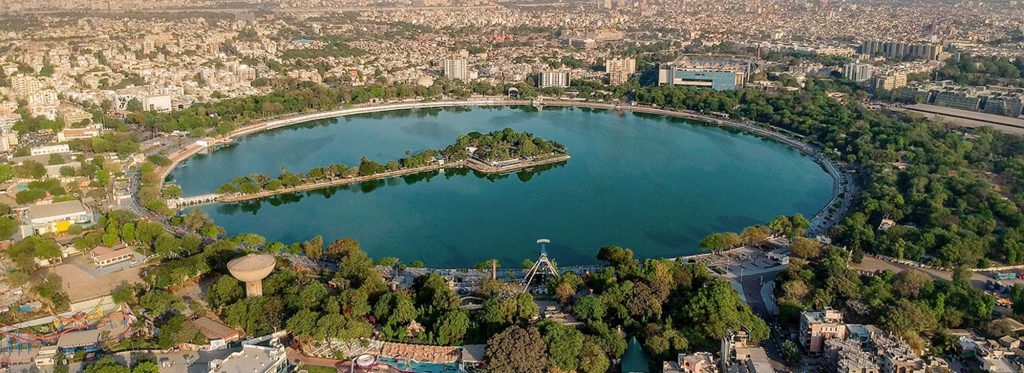
Kankaria Lake is one of the largest and most significant lakes in the state of Gujarat and is located in the city of Ahmedabad. This lake was established in the 15th century by Sultan Qutb-ud-Din and later underwent a complete makeover to become a lively place for leisure. There is a beautiful park built around the lake where people can go for a walk, enjoy the view of the lake and gardens, and participate in various recreational activities. Technological advancement has seen this place turn into a new-era recreation area that attracts many residents and tourists for leisure activities. Some of the tourist attractions at the Kankaria Lake complex are an aquarium, a zoo, and a toy train that operates on a circuit on the lake.
At the centre of the lake is a large circular body of water which is ideal for boating and for walking along the boardwalk. Around the park, there are all kinds of cafes, restaurants, fast-food places, and playgrounds for kids, as well as terrains for theatre and music performances. People who visit Kankaria Lake can view the various sites that are within the lake as well as engage in various activities. The infrastructure around the lake is clean and offers a wide range of services so that visitors can engage in a range of recreational activities from boating to attending an event in the area. Being one of the major tourist attractions of the city, Kankaria Lake has developed from an old structure to a modern tourist-friendly lake.
Swaminarayan Akshardham
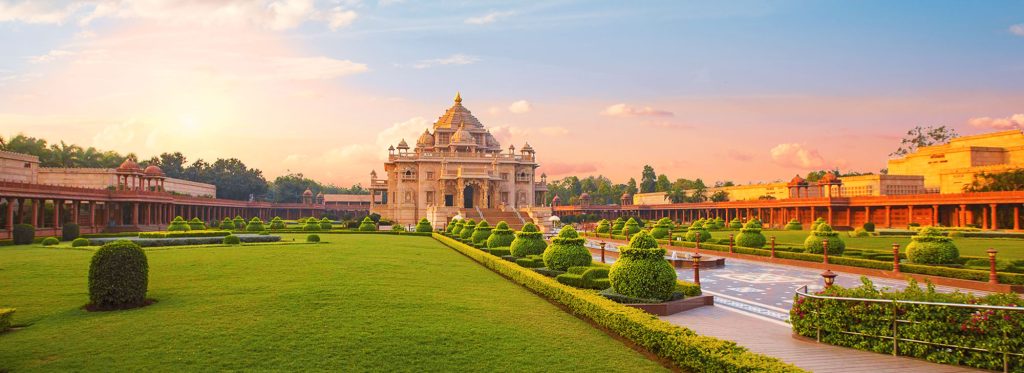
The Swaminarayan Akshardham Temple at Gandhinagar is one of the finest examples of modern Hindu architecture and devotion. It was established in 1992, the temple is for Bhagwan Swaminarayan and is famous for its marvelous architecture, beautiful sculptures, and calm and peaceful environment. The garbhagriha, the sanctum sanctorum, has a replica of Swaminarayan beautifully carved out of wood with intricate works of marble carving and paintings. The various attractions within this spiritual park include the main temple, exhibition area, and beautifully landscaped gardens. The building itself is made from pink sandstone and white marble and is decorated with detailed sculptures illustrating episodes from Hindu gods’ and spirituality.
In addition to its main structure and architecture, the exhibition hall can be used to show and narrate through the use of touch screens about the teachings of Swaminarayan and the purpose of the temple. The gardens surrounding the temple are known as the Yagnapurush Kund, which makes the environment of the temple more calm, and meditation can be done here. A visit to Swaminarayan Akshardham gives an experience of the modern architecture of the Hindu temple and spirituality. It is a very calm environment, and the art and architecture of the temple contribute to the aura of depth and reason for being. Swaminarayan Akshardham Temple is an iconic temple recognizable for its blend of spirituality and modern architecture; it is essential to any Gujarat tour.
Great Rann of Kutch
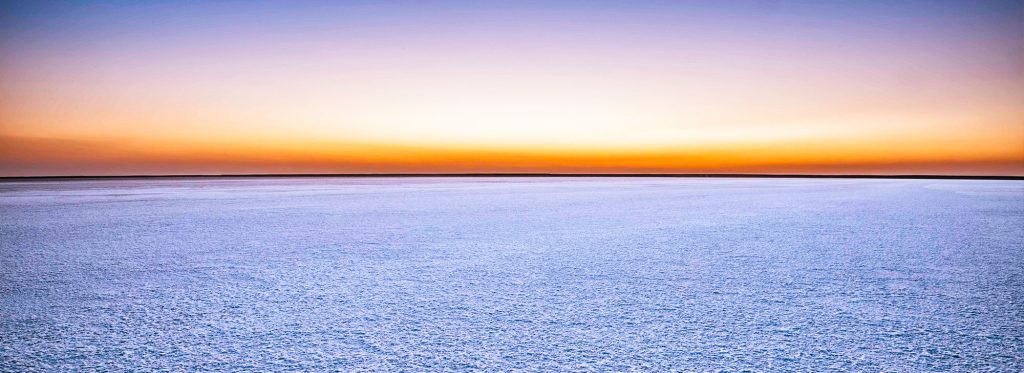
The Great Rann of Kutch is a large salty desert area situated in the Kutch district of Gujarat famous for its physical characteristics and festivals. Rann measures over 30,000 square kilometers and is one of the largest salt deserts globally, characterized by the white salt layer that makes it look like it is from another planet. The Rann is especially known as the Rann Utsav, an annual festival to showcase the cultural facades of Gujarat through music and dance, arts and crafts, food fiesta, etc. The Great Rann of Kutch is a large barren ground and also white and thus offers the perfect setting for photography and exploration. The area has a rich and diverse fauna and flora of migratory birds as well as other residents of the region making it an exciting destination for a nature lover and photographers.
Some of the temporary villages and campsites in the salt marsh are also well established and they normally show how the early people lived in the area. There are various things that tourists can do in Great Rann of Kutch including exploring the salt desert, joining in festivals, purchasing local handicrafts, and tasting Kutchi food. Due to its landscapes and cultural events, the region offers a remarkable destination to tourists with different orientations to immerse themselves in. Great Rann of Kutch is a real discovery for those who are eager to meet a great unusual civilization and the wonderful nature of Gujarat.
Conclusion
For tourists, Gujarat is a gold mine of attractions, offering countless sites that showcase its rich and colorful history. This Indian state is packed with historical landmarks, cultural gems, and beautiful landscapes, making it an exciting destination for anyone looking to explore its vibrant past and present. The journey begins with beautiful bohemian spots like the Gandhi Ashram and the Dwarkadhish Temple and ends with the technologically advanced Statue of Unity. Visit the royal wealth of the Lakshmi Vilas Palace, the work of the Adalaj Step-well, and the scenic beauty of the Rann of Kutch. When you are visiting these great attractions you will witness the essence of Gujrat at its finest. Take the opportunities that come your way and let Gujarat touch your heart.

